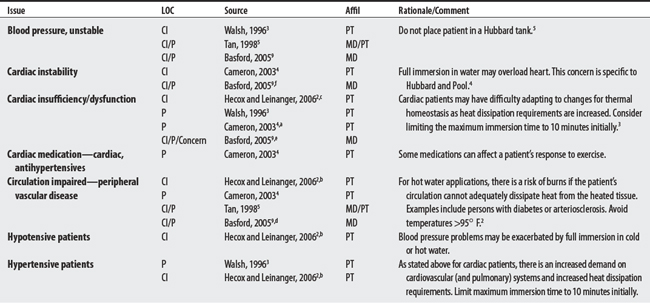Chapter 44 Hydrotherapy
INCLUDES FULL BODY IMMERSION; WHIRLPOOL EXCLUDES DEBRIDEMENT/WOUND CARE (SEE DEBRIDEMENT) EXCLUDES AQUATIC THERAPY (SEE AQUATIC THERAPY)
OVERVIEW.
Hydrotherapy is water treatment used for exercises, pain management, and wound care1 and includes whirlpool, pool therapy, and contrast baths. Hydrotherapy benefits are derived from its cleansing action, buoyancy properties (reduced weight bearing), hydrostatic pressure effects (improved venous return), and psychological effects.
Sources generally recommend monitoring patient vital signs (because of patients’ inability to lose heat while in water if fully immersed), check temperature levels, clean tanks, and caution to never leave patient unattended during or after hydrotherapy.2,3 Note: (1) Because of the potential for cross-contamination, aspiration, drowning, cardiovascular stress, and burns (in heated water), patient screening is required. (2) If hydrotherapy is used in conjunction with hot or cold water, then superficial heat and cryotherapy concerns also apply, respectively.3–5
OTHER ISSUES: ELECTROLYTE IMBALANCES IN BURNS, SLIPS, AND FALLS, AND HAIR ENTANGLEMENT.
(1) Said and Hussein,6 in a 1987 case series, reported on two brothers who sustained partial-thickness burns and subsequently developed hyponatremia while immersed in a whirlpool filled with tap water. (2) In a 1994 Missouri lawsuit,7 a man with arthritis was awarded $47,773.90 after he slipped and fractured his patella while being assisted out of a whirlpool bath. (3) The CPSC8 reported 43 incidences of hair getting sucked into suction fittings of spas, whirlpools, or hot tubs, including 12 deaths (the head of victim was trapped underwater).
CONTRAINDICATIONS AND PRECAUTIONS FOR HYDROTHERAPY
A00-B99 CERTAIN INFECTIONS AND PARASITIC DISEASES
D50-D89 DISEASES OF BLOOD AND BLOOD-FORMING ORGANS AND CERTAIN DISORDERS
F00-F99 MENTAL AND BEHAVIORAL DISORDERS
G00-G99 DISEASES OF THE NERVOUS SYSTEM
I00-I99 DISEASES OF THE CIRCULATORY SYSTEM
J00-J99 DISEASES OF THE RESPIRATORY SYSTEM

















